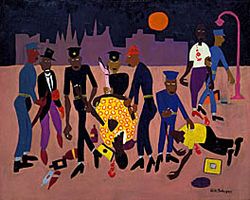Harlem riot of 1943 facts for kids
Quick facts for kids Harlem riot of 1943 |
|
|---|---|
| Date | August 1–2, 1943 |
| Location | |
| Caused by | Police Shooting |
| Casualties | |
| Death(s) | 6 |
| Arrested | 600 |
A serious event happened in Harlem, New York City, on August 1 and 2, 1943. It started after a white police officer, James Collins, shot and injured Robert Bandy, an African American soldier. This event led to many Black residents showing their anger, mainly towards businesses owned by white people in Harlem.
This was one of five similar events across the United States that year. These events were linked to tensions between Black and white people during World War II. Other places where similar events happened included Detroit, Beaumont, Texas, Mobile, Alabama, and Los Angeles.
The events in Harlem ended on the night of August 2. Cleanup work began right away. The New York City Department of Sanitation cleaned the area for three days. The New York City Departments of Buildings and Housing boarded up damaged windows. Police officers escorted all city workers to keep them safe. The Red Cross gave lemonade and crullers to people in Harlem. The mayor also arranged for hospitals to help the many injured people.
By August 4, traffic was back to normal in the area. Taverns reopened the next day. The mayor made sure food was delivered to Harlem residents. By August 6, food supplies were back to normal levels. In total, six people died and nearly 700 were injured. About 600 men and women were arrested because of the events.
Why it Happened
The main reasons for the events came from deep feelings among Black residents in Harlem. They felt that the promises of American freedom and fairness did not match their daily lives. They faced difficult social and economic conditions.
Unfair Treatment
Black soldiers serving in the United States military were separated from white soldiers. This made many Black residents upset. Also, wartime shortages made housing and supplies in Harlem even harder to get.
Daily Challenges
African Americans faced unfair treatment in jobs, both for the city and private companies. They also had problems getting good city services. These issues created a lot of tension as people tried to improve their lives. Robert Bandy, the injured soldier, became a symbol for Black soldiers who were treated unfairly, even as the U.S. fought for "freedom" around the world.
Art and Stories

The events in Harlem became a topic for many artists and writers.
- It was a key moment in Ralph Ellison's famous novel Invisible Man. This book won the 1953 National Book Award.
- It also set the scene for parts of James Baldwin's book Notes of a Native Son.
- Artist William Johnson painted a picture about it called Moon Over Harlem.

